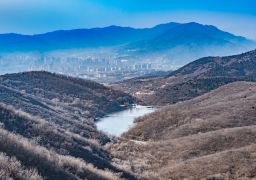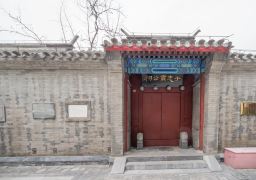Guyan Huaxiang is located in Dagangtou in the southwest of Lishui. Here there is a beautiful water town scenery that is both naturally beautiful and magnificent. It is especially beautiful for taking photos or sketching. Therefore, many art colleges and universities choose this place as a sketching base and it has the reputation of ‘Painting Town’. People creating with drawing boards can often be seen on the ancient riverside street, full of artistic atmosphere. And the Tongji Weir, a water conservancy project with a history of thousands of years, is a must-visit place for tourists who come to Guyan Huaxiang. The Oujiang River divides the scenic area into two parts. ‘Guyan’ is Yantou Village on the north bank, and ‘Painting Town’ refers to Dagangtou Town where the town government on the south bank is located. The two sides face each other across the river. There is no bridge, only painted pleasure boats shuttling between the two banks. Tourists usually arrive at Dagangtou first and then take a boat to Yantou Village on the opposite side. There are tourist centers on both sides. Tickets can be bought separately, but buying a combined ticket is slightly cheaper. The attractions of Dagangtou are concentrated on a street by the river with red lanterns – the ancient riverside street. Although it doesn’t show ancient charm after renovation, it can also be considered picturesque. Most of the shops on both sides of the street are art studios or shops related to painting. You can find some unique small items in the文艺特色小店 on the street, or send a postcard to relatives and friends at the He & She Love Post Office. At the east street entrance, there is an ancient camphor tree and the Shuangyin Pavilion named after it, which is very charming. Next to the pavilion is the ancient camphor wharf. You can take a ferry to Yantou Village on the opposite side here, or walk along the street to the Tongping Wharf near the photography exhibition hall to take a boat. The water of the Oujiang River is calm and very clean. The surrounding natural scenery is also very good. There are often small boats with white sails on the river, suitable for collecting scenery and taking photos. Taking a painted pleasure boat, you can soon reach Yantou Village on the opposite bank of the river. It should be noted that there are no cruise ships after five o’clock in the afternoon. Pay attention to the play time. There are many statues beside the landscape road from Guyan Wharf to the edge of the village, representing politicians, hydraulic engineers and poets related to Tongji Weir in past dynasties. After walking through a section of stepping stones, if you go forward at the fork, you can walk all the way along the river to Tongji Weir. If you turn right, you will lead to the Wenchang Pavilion in the north of the village. Walking west from the Wenchang Pavilion can also reach Tongji Weir. However, there are many ancient camphor trees and ancient dwellings along the way, and the cultural landscape is more abundant. Among them, the Wenchang Pavilion is a small two-story building surrounded by a large number of ancient camphor trees. Next to it is the three-hole bridge with three water diversion holes. To the south is the chastity archway of ‘Filial Piety and Thriftiness are Praised’ during the Jiaqing period, and there is also a ‘Prohibition’ stone tablet. Tongji Weir is an arched stone dam lying between the clear waters. On one side is the calm water surface with ripples, and on the other side is the turbulent water inlet, contrasting with the river beach covered with shrubs and scattered seagulls, which is very eye-catching. In the Zhnan Ersima Temple next to Tongji Weir, there are more than twenty water conservancy stone inscriptions since the Yuan Dynasty. You can learn about this large water conservancy project in Zhejiang over thousands of years through these inscriptions.
In Dagangtou, there are many places to stay, mostly quaint inns and farmhouses. The price of a standard room is around 200 yuan. If the budget is sufficient, you can stay in a better river-view room. In addition, the local fish are very famous, but of course the price is also not cheap. A catty of stream fish is about 45 yuan.
Opening hours: Open all year round from 08:00 to 17:30; open all year round from 08:00 to 16:30.
Preferential policies:
Children: Those under 6 years old (inclusive) or under 1.2 meters in height (inclusive) are free; those with a height of 1.2 meters (excluding) to 1.5 meters (inclusive) are half price.
The elderly: Those over 70 years old (inclusive) with senior citizen cards and ID cards are free; those aged 60 (inclusive) to 69 years old (inclusive) with senior citizen cards are eligible for discounted tickets.
Journalists: Free with valid documents.
Disabled people: Free with valid documents.
Retired cadres: Free with valid documents.
Full-time college students: Half price with valid documents.
Active servicemen: Half price with valid documents.
Teachers: Half price with valid documents.
Writers, artists, and photographers: Members of national-level writers’, artists’, and photographers’ associations (with relevant membership cards) are free.
Service facilities:
Parking lot: [Guyang Painting Township Parking Lot]. Reference price: free. Address: Near the Guyang Painting Township Scenic Area. Number of spaces: 500.
WIFI: Account: cmcc-gyhx-free. Password: no password. Coverage: full coverage.
Transportation within the park: Reference price: 20 yuan/person. Address: Camphor Tree Wharf/Baoding Wharf. Only for Liandu District, Lishui. The regular tourist tickets already include round-trip boat tickets and there is no need to purchase separately.
Toilets: There are multiple toilets in the scenic area. Near the ticket hall and scenic area entrance, there are eye-catching signs.
Guyan Huaxiang Scenic Area
Guyan Huaxiang is located in Dagangtou in the southwest of Lishui. Here there is a beautiful water t[...]









